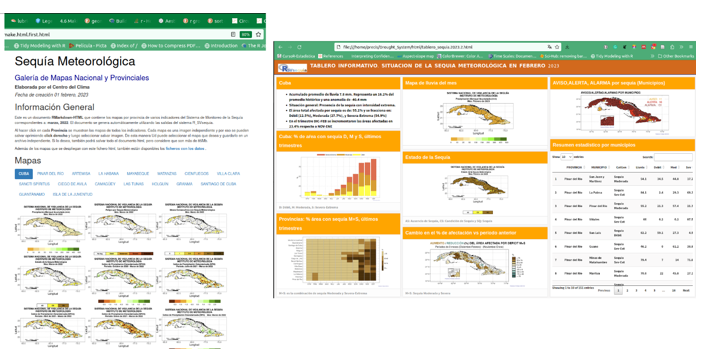R_SVsequia: A New automatic climate service for meteorological drought monitoring in Cuba
Main Article Content
Abstract
In this work we describe the development of R_SVsequia a new automatic system for rainfall processing and drought monitoring at INSMET. The application was developed using RStudio IDE and the R software and has the ability to perform all the tasks with a high level of efficiency and operability. The execution of R_SVsequia only depends on rainfall data from the National Institute of Hydraulic Resources and of a set of parameters that an be passed through a name list file. The system produces many data files which are summarized as tables, graphs and maps for monitoring purposes or can be used for research activities. Several types of the system outputs are totally new and could increase the ability of climate experts to produce better analysis and reports. In essence, R_SVsequia represents a innovation to the climate service framework related with drought monitoring adding efficiency, versatility and reliability in the execution of processes and their results, compared to previous systems.
Downloads
Article Details

This work is licensed under a Creative Commons Attribution-NonCommercial 4.0 International License.
Those authors who have publications with this journal accept the following terms of the License Attribution-NonCommercial 4.0 International (CC BY-NC 4.0):
You are free to:
- Share — copy and redistribute the material in any medium or format
- Adapt — remix, transform, and build upon the material
The licensor cannot revoke these freedoms as long as you follow the license terms.
Under the following terms:
- Attribution — You must give appropriate credit, provide a link to the license, and indicate if changes were made. You may do so in any reasonable manner, but not in any way that suggests the licensor endorses you or your use.
- NonCommercial — You may not use the material for commercial purposes.
- No additional restrictions — You may not apply legal terms or technological measures that legally restrict others from doing anything the license permits.
The journal is not responsible for the opinions and concepts expressed in the works, they are the sole responsibility of the authors. The Editor, with the assistance of the Editorial Committee, reserves the right to suggest or request advisable or necessary modifications. They are accepted to publish original scientific papers, research results of interest that have not been published or sent to another journal for the same purpose.
The mention of trademarks of equipment, instruments or specific materials is for identification purposes, and there is no promotional commitment in relation to them, neither by the authors nor by the publisher.
References
Fonseca, C. M., Ramos, I., Puig M. A., Mesias R. (2018). ¡Pon tu Ficha! Procedimiento General del Sistema de Alerta y Acciones Tempranas para la Sequía. proyecto “Fortalecimiento de las capacidades nacionales y locales para el manejo integral de la sequía a fin de reducir sus impactos sobre la seguridad alimentaria y nutricional y el suministro público de agua en las provincias orientales de Cuba”. PMA-PNUD, 49 pp.
Gibbs, W.J., Maher J.,V. (1967). Rainfall deciles as drought indicators. In: Bureau of Meteorology, Bulletin No. 48, Melbourne. Australia
INSMET (2014). Manual de Procedimientos del “Sistema de Vigilancia y Alerta Temprana de la sequía meteorológica”. Documento de trabajo del Grupo de Vigilancia de la Sequía. Centro del Clima, Instituto de Meteorología.
Lapinel, B. P., Rivero, R.E., Rivero, R.R., Varela, N., Cutié, V. y Fonseca, C. (2006): El Sistema Nacional de Vigilancia y Predicción de la Sequía en Cuba: Caso de Estudio. En “Solano, O., H. Shannon y R. Villalobos (Eds.) (2006): Informe del Grupo de Trabajo sobre Meteorología Agrícola de la AR IV”.
Lapinel, B., V. Cutié, C. Fonseca y R. Báez. (2007). “Sistema de Diagnóstico, Vigilancia y alerta Temprana de la Sequía”. Guía de Técnicas y Procedimientos. Proyecto GEF-PNUD RLA/01/G31.
Lapinel, B. P., Fonseca C., González I., González C., et al (2014): Metodología para el estudio de peligro, vulnerabilidad y riesgo por intensa sequía. En: “Cuba: metodologías para la determinación de riesgos de desastre a nivel territorial”, PNUD-Cuba, ISBN: 978-959-300-033-8, 114 pp.
McKee, T.B., Doesken, N.J., Kleist, J. (1993): The relationship of drought frequency and duration to time scales. In Proceedings of the Eighth Conference on Applied Climatology. Am. Meteorol. Soc., 17, 179–184.
Wickham Hadley and Garrett Grolemund (2017): R for Data Science, O’Reilly Media, Inc. Pp 520
Wilkinson, L., Friendly, M. (2009): "The History of the Cluster Heat Map". The American Statistician. 63 (2): 179–184. doi:10.1198/tas.2009.00332014

